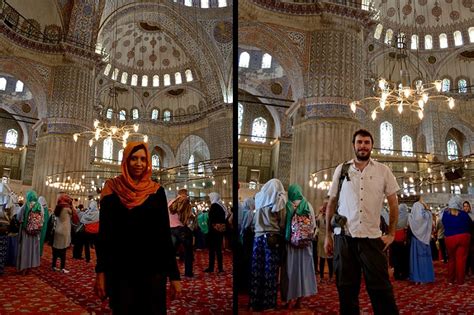Discover essential dress code guidelines for mosque visits, including fabric choices, modesty, accessories, and the importance of appropriate attire in these sacred spaces.Visiting a mosque is not only an opportunity for spiritual enrichment but also a chance to engage with a vibrant cultural heritage. However, dressing appropriately is crucial to show respect for the sacred space and its traditions. In this article, we will explore the significance of dressing well when visiting mosques, offering essential guidelines to ensure you adhere to the expected etiquette. We will delve into key dress code guidelines, tips on selecting the right fabrics and colors, and the importance of modesty in your outfit choices. Additionally, we will provide insights on how to accessorize your attire effectively, helping you present yourself in a way that honors the customs of the mosque. Whether you are a first-time visitor or seeking to enhance your understanding, our comprehensive guide will equip you with everything you need for a respectful and enjoyable visit.
Understanding The Importance Of Dressing Appropriately In Mosques
Dressing appropriately when visiting mosques is crucial for several reasons, reflecting respect for the sacred environment and the cultural significance of these places of worship. Understanding the importance behind the dress code can enhance your overall experience and show proper etiquette.
Firstly, mosques are spiritual sanctuaries for Muslims, representing a direct connection to their faith and community. By wearing suitable attire, visitors acknowledge the sanctity of the space and the rituals practiced within. This act of respect promotes a harmonious atmosphere and reflects well on visitors, fostering a sense of understanding across cultures.
Secondly, adhering to the dress code helps to avoid drawing unnecessary attention and distractions during prayers and other religious activities. In a mosque, the focus is on spirituality and community, not on individual fashion choices. By dressing modestly, you contribute to a collective environment where all participants can connect deeply with their faith.
It’s also important to recognize that the dress code may vary depending on the specific mosque and its cultural background. Understanding how to dress appropriately means being aware of local customs and practices, which can differ widely across different regions and communities.
| Aspect | Importance |
|---|---|
| Respect | Shows respect for the mosque and its community. |
| Focus | Minimizes distractions during worship and gatherings. |
| Cultural Awareness | Demonstrates understanding of local customs and practices. |
Recognizing the significance of dressing appropriately in mosques is essential for fostering respect and understanding. By being mindful of your attire, you contribute positively not only to your experience but also to the atmosphere of reverence and unity that mosques embody.
Key Dress Code Guidelines For Mosque Visitors
When planning a visit to a mosque, adhering to the dress code is essential to show respect for the sacred space and its traditions. Here are some key guidelines to follow:
- Ensure modesty: It is important to wear clothing that covers your body appropriately. For men, this typically means wearing long trousers and a shirt with sleeves. For women, loose-fitting clothing such as long dresses or skirts along with a long-sleeved top is recommended.
- Avoid tight-fitting clothing: Loose garments are preferable as they promote modesty. Tight clothing can be seen as inappropriate in a mosque setting.
- Head coverings for women: Women are generally expected to cover their hair while in a mosque. A scarf or shawl is a suitable option, and it should be worn in a way that covers the hair and neck.
- Footwear considerations: Most mosques require visitors to remove their shoes prior to entering. Therefore, wearing easily removable footwear is advisable. Also, ensure that your socks are clean as they will be seen when you take off your shoes.
- Neutral colors and simple designs: Choose clothing in neutral or subdued colors. Extravagant patterns and flashy colors may not be appropriate in a setting meant for reflection and prayer.
- Avoid excessive accessories: Keep accessories to a minimum. Simple jewelry is acceptable, but avoid large or distracting pieces that may draw attention away from the worship experience.
By following these how to dress code guidelines, visitors can ensure their attire is respectful and appropriate for the mosque environment, contributing to a more peaceful and welcoming atmosphere for everyone.
How To Choose The Right Fabrics And Colors For Mosque Visits
When considering how to dress appropriately while visiting mosques, the selection of fabrics and colors plays a crucial role in ensuring comfort and respect for the sacred environment. Here are some tips on how to choose wisely:
| Color | Meaning/Significance | Recommended Fabrics |
|---|---|---|
| White | Purity and peace | Cotton, linen |
| Black | Elegance and modesty | Silk, wool |
| Earthy tones (browns, greens) | Connection to nature | Bamboo, organic cotton |
| Pastels | Softness and approachability | Chiffon, cotton blends |
When it comes to fabrics, breathable materials are preferable, especially in warmer climates, as they allow for better airflow and comfort during prayers. Fabrics such as cotton, linen, and lightweight wool are great choices. Additionally, consider the season and weather when planning your outfit.
In terms of colors, it is often best to select shades that reflect modesty and humility. Avoid overly bright or flashy colors that may attract undue attention. Neutral and softer tones are typically more acceptable in the context of a mosque visit. Ultimately, understanding how to choose the right fabrics and colors will enhance your experience while ensuring that you respect the traditions of the mosque.
The Role Of Modesty In Mosque Attire Choices
When visiting a mosque, understanding the role of modesty in your attire is crucial. Modesty is not merely a matter of following a dress code; it reflects deep respect for the sacred environment and the customs of the community you are joining. Dressing modestly signifies an acknowledgment of the spiritual significance of the mosque and the values upheld by Islam.
In many cultures, especially those that predominantly practice Islam, modesty in dress is a core principle. For men, this often means wearing loose-fitting clothing that covers the arms and legs, while for women, it typically involves garments that are not only loose but also cover the hair. The purpose of these guidelines is to minimize distractions and foster an atmosphere of reverence during prayers and reflections.
When choosing your attire for a mosque visit, consider the following points:
Modesty goes beyond physical appearance; it embodies a respectful attitude and mindset. By dressing modestly, visitors not only comply with the expectations of the mosque but also contribute to a peaceful and harmonious vibe among all attendees. Embracing this principle enriches the overall experience and encourages a stronger connection with the spiritual ambiance of the mosque.
How To Accessorize Your Outfit For A Mosque Visit
When planning your outfit for a mosque visit, the right accessories can enhance your overall look while still adhering to the how to dress appropriately. Here are some tips to consider when selecting accessories:
- Scarves: A simple, elegant scarf can not only add a touch of style but also serve as an additional layer of modesty. Choose lightweight fabrics in neutral or pastel shades that complement your outfit.
- Jewelry: Keep your jewelry minimalistic and understated. Opt for small earrings or a delicate necklace to maintain a respectful appearance without being overly flashy.
- Bags: Select a small to medium-sized bag that is practical and easy to carry. A simple clutch or a crossbody bag in a neutral color can be both functional and stylish.
- Shoes: Comfortable footwear is essential, especially if you plan to walk or spend time standing. Closed-toe shoes or sandals with a low heel are generally appropriate. Avoid overly casual flip-flops or shoes that might distract from your overall appearance.
- Headwear: While head coverings are often required for women, scarves or hats can also be a stylish addition for men. Choose headwear that is discreet and should ideally match your outfit.
Accessories should complement your attire while respecting the mosque’s environment. Remember that the aim is to present yourself in a way that is both modest and mindful of the space you are entering. By carefully selecting the right accessories, you can achieve a balanced and respectful appearance that aligns with the principles of visiting a mosque.
Frequently Asked Questions
Why is it important to dress appropriately when visiting a mosque?
Dressing appropriately shows respect for the sacred space and the customs of the Muslim community, which often emphasizes modesty and reverence.
What are typical dress codes expected at mosques?
Typical dress codes include wearing loose-fitting clothing that covers the arms and legs. Women may also be required to cover their hair.
Are there any specific clothing items that should be avoided?
Yes, clothing items that are tight, revealing, or have offensive imagery should be avoided to maintain respect within the mosque.
Can I wear shoes in the mosque?
Generally, shoes are not allowed inside mosques. Visitors should wear socks or remove their shoes before entering the prayer areas.
What should women wear when visiting a mosque?
Women are typically expected to wear loose-fitting clothing that covers their arms and legs and may also need to wear a headscarf.
Is there any flexibility in the dress code depending on the region?
Yes, dress codes can vary significantly depending on cultural norms and the specific mosque, so it’s best to research local customs beforehand.
Are there any resources to help visitors prepare for a mosque visit?
Many mosque websites provide visitor guidelines, and several travel blogs offer tips on appropriate attire and etiquette when visiting.




